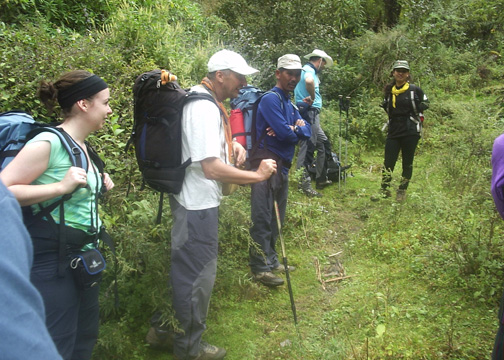
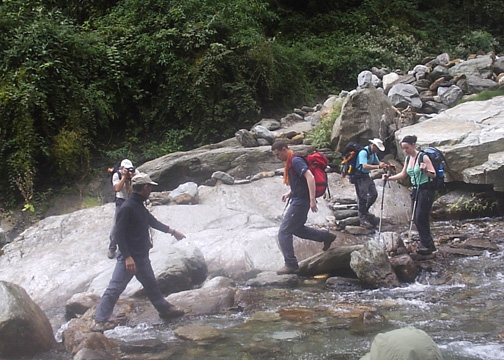
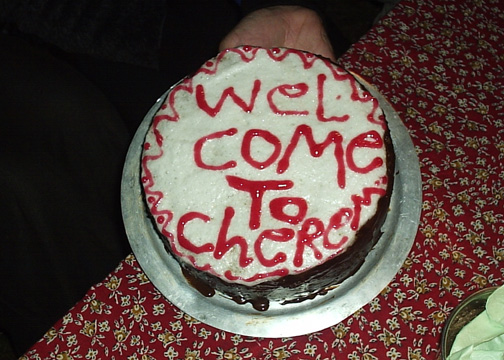
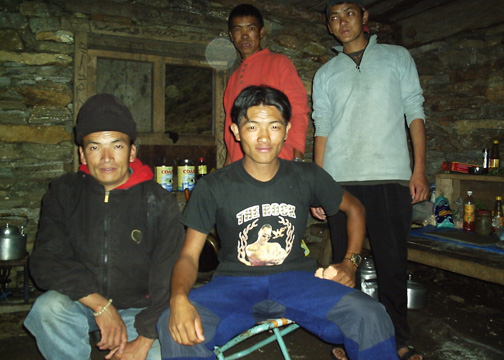
MERA PEAK, NEPAL
 |
 |
 |
 |
A diary of my trip to Mera Peak, Nepal in 2005 - Days 6 -7.
(Click on any of the pics to see the full size photograph)
Day
6 - Thursday 20th October - Another early
get up call but today the clouds had disappeared and we had wonderful views in
every direction. Could see the path we'd walked along yesterday in the clouds -
glad we hadn't stepped off to the right! From our campsite we can see
Cherem
across the valley which is where we're heading to today - easy according to
Robin - so where's the cable car station? Earlier we were having the usual chit
chat over breakfast and Robin drops in that today's going to be an easy day but
with a few "interesting" bits - Gombu and Lambabu are smiling - that worries me
- the mind boggles as Robin quickly drops in the route - paddy fields,
waterfall, ladder, maybe ropes, river, bridge, climb up to
Cherem - easy half
day - ok - sure, lead on - waterfall?? - ropes?? - hadn't brought my cossie!
The landscape and vegetation
were changing each day and even during the day as we progressed and went higher.
As I said earlier, acclimatisation is vital and we tended to vertically zig zag
(imagine a graph) our way along throughout the trek, going up, dropping down,
then back up, often sleeping lower than the highest point we'd reached. It's
recommended not to go up more than 1000ft (300 metres) per day - doesn't sound
much but it is and will take its toll on you the higher you go, if you ignore
it. The vegetation in the valleys is lush, thick green forest with narrow paths
that have to regularly have the vegetation cut back. This thins out to hardy
grass land at the point we were at but later, as will be seen in the pictures,
it becomes just rocks, ice and snow - an amazing contrast not only over the
length of the trip but during the day.
We duly set off down the fields
on a narrow path heading into the valley, taking in the scenery and not thinking
about what may be about to come. The trees looking surreal from a distance -
like huge creatures. The bamboo or maize or whatever had been cut and put into
the trees to stop the animals from reaching them and probably also to stop them
rotting on the ground. The vegetation gradually thickened until we were in
forest/jungle, the path being mud and stones that were slippery from the rain
the night before. Eventually, we reached the waterfall area which was very
steep, wet (as you'd expect) and slippery. The sherpas helped us all down - just
don't look down!! Next little treat was a wooden ladder type structure
(basically a couple of branches with footholds chopped into them) under a rock
overhang that at the time I didn't think was too bad. As he later told us this
was where Robin had thought we might have needed ropes - couldn't see why. As I
got to the overhang Lambabu was there standing on an edge and helping us onto
the "ladder" and under the rock. I'm 6ft tall and it was a bit of a squeeze with
a backpack on as well but I was concentrating so much on these footholds I
hadn't noticed anything else. Good job I was because what I didn't know until
afterwards was that immediately next to the "ladder" was a vertical drop of
about 100-120 ft and Lambabu had been standing right on the edge!! The porters
and kitchen crew went the same way that we did and I've no idea how they came
down the waterfall and under the overhang carrying those loads - mountain goats
springs to mind.
Eventually, we reached the base
of the waterfall where there was a log bridge over the fast flowing river. This
one was nothing like the first one we'd been on and was only three logs wide -
with no rails or rope to hold onto and not all the logs were completely secure. Lambabu helped most of us across,
including me (he was walking backwards!) - I
don't care, call me a wimp. We then dropped down through the undergrowth until
we reached the 'new' metal bridge over the Hinku river gorge. This bridge was funded
by
The Cherem Development Project and a couple of major sponsors. The parts of
bridge were carried by porters for days to reach here and then assembled by the
villagers of Cherem. It took them three attempts to get it right but now its
here permanently as opposed to the old wooden bridge that had to be rebuilt a
couple of times a year as it would get washed away. Its absolutely amazing, the
villagers needed it, they went to get it, carried it here and assembled it - no
helicopters, no lifting gear, no engineers - if you need something badly enough
in life you will do something about it. Great views from the bridge both up and
down river.
If you go downhill, you have to
go back up again and today was no exception. Leaving the river behind we had a
long steep climb for a couple of hours up to Cherem, through damp forest/jungle
that gave way to open fields. We had lunch sat in the wet undergrowth on the
blue tarpaulin which had been thrown over the vegetation. We had to keep an eye
out as there were leeches in the forest and one appeared on the tarpaulin off a
tray. Looking across the valley we could see the waterfall area we'd come down. Shortly after lunch we met four women who had come down from Cherem into
the forest to greet us with flasks of salted tea - lot of laughing and joking
with Gombu, Lumbabu and Galzin who are all from Cherem.
We arrived in Cherem at about
2:30 pm - as usual I was towards the back and got a cheer from the others
as we back markers arrived. I'd been videoed yesterday arriving for lunch and
was expecting the same again. "Where's the reception then?" I shouted - clang -
just around the corner the whole of the village had turned out to greet us -
good job none of them could speak English! We entered the village centre through
an archway which the villagers had created and covered with greenery and
flowers. There was a sign on it, roughly translated as "Welcome to Cherem we
respect our visitors like heroes" - this presumably referred to all the good
work done by Robin and Gombu for the village. It was amazing and humbling - they
gave us silk scarves, garlands of flowers and yet more salted tea which we drank
inside the gompa (monastery). The old monk/lama was in there - he's about 89/90
years old and Chappell's father. Grahame didn't feel too good and was feeling
very cold - Robin persuaded him to get into a sleeping bag in the tent to warm
up.
Soon after we arrived in Cherem
the clouds closed in again and it started to rain. I'm just sitting in the tent
now writing this diary and waiting for dinner - thank goodness we don't have to
cook it. Amazing the amount of clothes you wear in one day - started with tee
shirt plus long sleeved shirt plus body warmer, then soon down to just a tee
shirt but now I'm here at 4:15 pm wearing a tee shirt, long sleeve shirt, body
warmer and fleece but I'll need my ski jacket shell and gloves as well for dinner.
Some of the porters set off for Bung to get more supplies. They'll be back tomorrow lunchtime. Gombu reckons they'll take three hours to get there and we'd take two days!! Don't know whether it puts it in perspective or us to shame or both!! Tomorrow evening there's a meeting of the whole village to discuss, with Robin and Gombu, the proposals for future projects that the villagers need - they will make the suggestions and decisions as its their lives that are directly affected.
|
Lama inside the Gompa
|
Little boy with flask drinking salted tea inside the Gompa
|
Little boy inside the Gompa
|
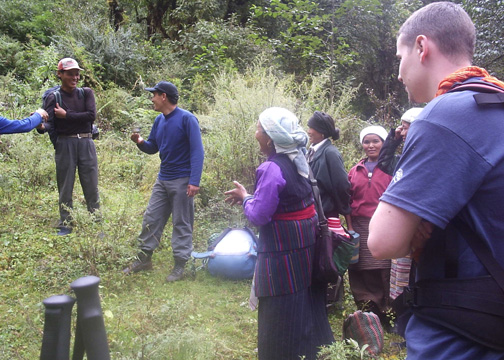 Lambabu on his last cup of tea, watched by the ladies, Galzin & Dan
|
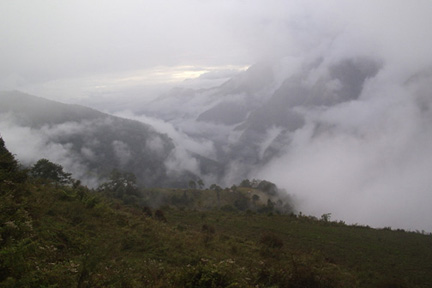 Evening clouds rolling in
|
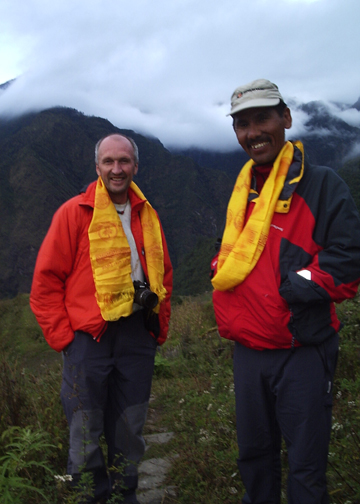 Day
7 - Friday 21st October - A rest day. We
had a slightly later warm water and morning tea at 7:00am with breakfast at 9. I
decided to eat less today as I was continually feeling bloated due to all the
food we were being given. My original thought was to skip breakfast but I
couldn't resist a fried egg when I saw them. We stayed today
in Cherem for a mixture of reasons - part of the acclimatisation process, a
chance to catch up on some washing - ourselves and our clothes - and because
Robin and Gombu had arranged a meeting with the villagers tonight to discuss the
future works to be funded by the
Cherem Development Project. It
felt strange not to be on the move.
Day
7 - Friday 21st October - A rest day. We
had a slightly later warm water and morning tea at 7:00am with breakfast at 9. I
decided to eat less today as I was continually feeling bloated due to all the
food we were being given. My original thought was to skip breakfast but I
couldn't resist a fried egg when I saw them. We stayed today
in Cherem for a mixture of reasons - part of the acclimatisation process, a
chance to catch up on some washing - ourselves and our clothes - and because
Robin and Gombu had arranged a meeting with the villagers tonight to discuss the
future works to be funded by the
Cherem Development Project. It
felt strange not to be on the move.
We all took the opportunity to
wash our clothes, as did the porters, using the standpipe and stone slab in the
centre of the village. This was also the time and place for your personal
ablutions - not much privacy so do what you can. It felt great to wash my hair
and splash some water around me especially knowing it was going to be quite a
while until the next time I could do it, so I spent most of the morning having a
good wash, washing my hair and washing my clothes. A couple of years earlier and we'd have
had to walk 1.5 kms to get the water but thanks to the
Cherem Development
Project the villagers have running water (from a hosepipe) now. It
was very sunny and warm so I thought everything would dry quickly - wrong - the
sun went in during the afternoon and it rained again later.
One of the village mothers
brought her young daughter (maybe 4 or 5 years old) to see us as the girl had a
badly infected ear which was almost raw and oozing puss. Out here there aren't
any doctors, hospitals or medicines - they would have had to walk for days to
find one. Susmita cleaned the girl's ear as best she could and applied some
antiseptic cream to try to help. It looked a lot better. The little girl just
sat there motionless and without saying a word or crying while she was being
treated - I couldn't imagine a child back home doing that with what was being
done. Really she needed some antibiotics but we couldn't give her any. We had
some medicines and antibiotics with us but we we had to have them with us at
higher altitudes in case we suffered problems up there. Believe me - a real
moral dilemma.
We generally sat around for a
few hours, soaking up the sunshine, hoping our washing would dry - which it
didn't, sorting out our crampons and double layer boots as well as re-packing
our bags. The kids arrived after school had finished and we had a great time
with them as they were singing and dancing for us - Grahame videoed it (all).
While this was going on the ladies of the village all came to join us and the
school kids. They were all turned out in their
finery to be photographed as well so Robin used this as an opportunity for some
more 'Sprayway' pics. He also wanted to use several other locations in the
village and we just tagged along until the light started to fade.
We then went "socialising" with
Robin and Gombu to three houses - out came the salted tea and the local hooch.
They continually fill your cup up and no isn't a word they listen to. The houses
all have a solar panel now that powers a battery. This in turn gives enough
power for two 40w fluorescent lights (about 15" long) in each house. The layouts
of the houses are all basically the same - animals on the ground floor with one
room on the first floor which is where the family eat, live and sleep. There's
an open fire (no chimney breast) and the smoke goes through a hole in the
ceiling into the roofspace and then out between the roofing stones.
We had an early dinner tonight and the kitchen crew baked us a chocolate cake with icing and the wording "Welcome to Cherem" on it - a wonderful surprise.
In the evening we went to a
village meeting in the Gompa where the villagers discussed with Robin and Gombu
what they would like next for the village. After a lot of discussion it was
agreed that:
(i) a new metal bridge would be provided over a second river (which we will cross tomorrow)
(ii) a villager, who has graduated from the school, would be trained as a first aider and classroom assistant (the nearest first aid or doctor is two days away - Nepalese walking days, not ours!)
(iii) continue scholarships for five students after they leave the school - the cost is £450 per annum for all 5!!
The lama had wanted a new prayer book and another floor on top of the Gompa but the villagers voted against them as these were too expensive and they preferred things that were more practical and urgent at the present time. Ewan had some dollars with him which he very kindly donated to the villagers for the Cherem Development Project and for which the villagers sincerely thanked him. They decided to split the money evenly between two of the proposed projects. The rest of us had left most of our money back in Kathmandu but I'm sure we all made a mental note to donate some or raise some funds for the village in the future. The villagers then partied (serious singing, dancing and drinking) until midnight although we visitors left at about 9 - we couldn't keep up with them.
Cherem is a small isolated community that relies on growing its own food (mainly potatoes) and the money made from portering. We saw one guy ploughing a field today with a wooden plough and a couple of oxen - it took him all day - using a tractor it would have taken about an hour. It is hoped to develop a trekking trail through the village to Mera Peak instead of the other routes now used by most trekking companies. The people have nothing but gladly share everything with you.
|
View from Cherem village
|
Diary Days 1-3 | 4-5 | 8-10 | 11-13 | 14-16 | 17-19 | 20-end
The Cherem Development Project
All contents copyright of Bob Hancock